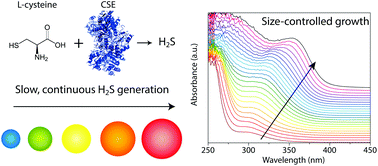Our official English website, www.x-mol.net, welcomes your
feedback! (Note: you will need to create a separate account there.)
Low temperature aqueous synthesis of size-controlled nanocrystals through size focusing: a quantum dot biomineralization case study†
Nanoscale ( IF 5.8 ) Pub Date : 2018-10-31 00:00:00 , DOI: 10.1039/c8nr06166a Leah C. Spangler 1, 2, 3, 4 , Joseph P. Cline 2, 3, 4, 5 , Christopher J. Kiely 1, 2, 3, 4, 5 , Steven McIntosh 1, 2, 3, 4
Nanoscale ( IF 5.8 ) Pub Date : 2018-10-31 00:00:00 , DOI: 10.1039/c8nr06166a Leah C. Spangler 1, 2, 3, 4 , Joseph P. Cline 2, 3, 4, 5 , Christopher J. Kiely 1, 2, 3, 4, 5 , Steven McIntosh 1, 2, 3, 4
Affiliation

|
Traditional quantum dot synthesis techniques rely on the separation of nucleation and growth to control nanocrystal size. However, the same goal can be achieved through slow and continuous introduction of reactive precursors to keep the growth mechanism in the size focusing regime throughout synthesis. In this work, we demonstrate the efficacy of this approach within the framework of functional material biomineralization where, despite simultaneous nucleation and growth of particles, this growth mechanism enables size-controlled nanocrystal synthesis. Herein, the single enzyme cystathionine γ-lyase (CSE) is utilized to biomineralize CdS nanocrystals via the slow, but continuous turnover of the amino acid L-cysteine to produce H2S. Nanocrystal nucleation and growth theories confirm that consistent addition of monomers will result in a high supersaturation term, driving the nanocrystal growth mechanism into the size focusing regime. We further confirm this theory by mimicking biomineralization via chemical routes and demonstrate the influence of varying supersaturation, to further control the average nanocrystal size. Finally, altering the chelation strength of the capping agent L-cysteine is found to play a key role in balancing nanocrystal growth in solution and long-term stability.
中文翻译:

通过尺寸聚焦的低温水合成尺寸可控的纳米晶体:量子点生物矿化案例研究†
传统的量子点合成技术依靠成核和生长的分离来控制纳米晶体的尺寸。但是,可以通过缓慢连续地引入反应性前体,以使整个合成过程中的生长机理保持在尺寸集中的状态,从而实现相同的目标。在这项工作中,我们在功能材料生物矿化的框架内证明了该方法的有效性,尽管同时发生了成核和颗粒生长,但这种生长机制仍可实现尺寸受控的纳米晶体合成。在本文中,单一酶胱硫醚γ-裂合酶(CSE)用于通过缓慢但连续的氨基酸L-半胱氨酸周转产生C 2来生物矿化CdS纳米晶体。S.纳米晶体的成核和生长理论证实,单体的持续添加会导致较高的过饱和度,从而将纳米晶体的生长机制带入了尺寸聚焦机制。我们通过通过化学途径模拟生物矿化进一步证实了这一理论,并证明了变化的过饱和度的影响,以进一步控制平均纳米晶体的尺寸。最后,发现改变封端剂L-半胱氨酸的螯合强度在平衡溶液中纳米晶体的生长和长期稳定性中起关键作用。
更新日期:2018-10-31
中文翻译:

通过尺寸聚焦的低温水合成尺寸可控的纳米晶体:量子点生物矿化案例研究†
传统的量子点合成技术依靠成核和生长的分离来控制纳米晶体的尺寸。但是,可以通过缓慢连续地引入反应性前体,以使整个合成过程中的生长机理保持在尺寸集中的状态,从而实现相同的目标。在这项工作中,我们在功能材料生物矿化的框架内证明了该方法的有效性,尽管同时发生了成核和颗粒生长,但这种生长机制仍可实现尺寸受控的纳米晶体合成。在本文中,单一酶胱硫醚γ-裂合酶(CSE)用于通过缓慢但连续的氨基酸L-半胱氨酸周转产生C 2来生物矿化CdS纳米晶体。S.纳米晶体的成核和生长理论证实,单体的持续添加会导致较高的过饱和度,从而将纳米晶体的生长机制带入了尺寸聚焦机制。我们通过通过化学途径模拟生物矿化进一步证实了这一理论,并证明了变化的过饱和度的影响,以进一步控制平均纳米晶体的尺寸。最后,发现改变封端剂L-半胱氨酸的螯合强度在平衡溶液中纳米晶体的生长和长期稳定性中起关键作用。










































 京公网安备 11010802027423号
京公网安备 11010802027423号